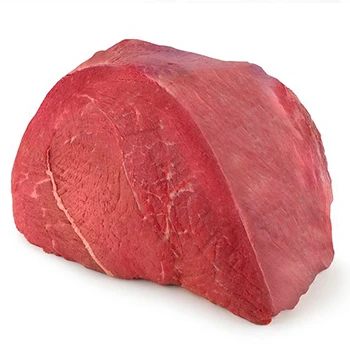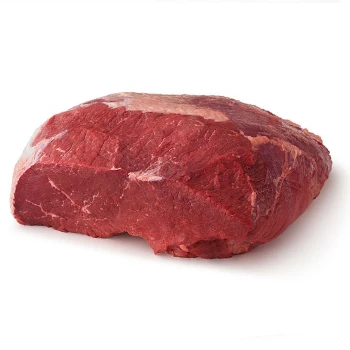I grew up eating roast beef every Sunday. This was my family’s favorite meat, and it quickly became my go-to when I turned to a carnivore lifestyle.
In the meantime, I learned the most important part of cooking roast beef is picking the right cut.
I’ve made countless roast beef dishes over the years and experimented with different cuts.
Here’s the ultimate list of the best cuts of meat for delicious roast beef.
Quick Summary
- You can choose between various cuts of meat for making roast beef, such as rolled rib roast, round tip roast, and many other cuts.
- Different cuts have different amounts of fat and should be prepared and cooked differently.
- Roast beef cuts differ in terms of price. You can choose between a more affordable or an expensive cut.
What Cut of Meat is Roast Beef Made From?
Roast beef is usually made from a cut like bottom round rump, chuck, sirloin top, or eye of round roast. Other options include top round, prime rib, brisket, and shoulder petite.
Depending on the cut you choose, you’ll need to use different cooking methods and temperatures.
1. Bottom Round Rump

The bottom round rump is one of the best cuts you can get for roast beef because it’s thick, inexpensive, and pairs great with most sides.
This is a budget cut. It comes from the cow’s rear leg, so it’s a lean cut. You can also find it labeled as London broil when cut into steaks [1].
The bottom round rump is best used for low and slow roasting.
Get a 4-pound bottom round rump cut for eight to ten servings and cook it at a temperature of 275 degrees for rare or medium rare doneness. The meat’s internal temperature should be around 135 degrees.
2. Chuck Roast
Chuck roast comes from the cow’s shoulder area. This area gets a lot of exercise, so this is a tough and beefy cut that’s best slow-cooked. You can braise it or cook it in a crockpot too.
Chuck roast has a lot of connective tissue, mainly collagen, which needs time to render but results in soft meat nonetheless.
Chuck roast is the best cut if you don’t like roast beef with a pink or red center. Plus, it’s inexpensive. You should let it rest after cooking for the best juiciness.
Chuck can be used for a pot roast or a stew when cubed. It’s also commonly used for hamburgers because it has a 20 to 80 fat-to-meat ratio [2].
Also Read: Chuck Roast vs Pot Roast
3. Sirloin Tip Roast

This is another budget cut with a rich beefy flavor similar to a more expensive tenderloin roast.
This cut got its name because it’s next to the sirloin’s tip. It comes from the round primal and is a great choice for roast beef because it has a lot of connective tissue without fat.
The tissues break down when you cook it low and slow, for example, braise or stew.
Note: Make sure to cook this cut for a long time, or the connective tissue won’t break, and you’ll have a dry roast.
4. Eye of Round Roast
Eye of round roast is the best choice for roast beef if you want an inexpensive cut. It comes from the round primal, which is a well-exercised rump and rear leg. It’s low in fat, which makes it very lean.
You should marinate the meat to make up for its lack of fat. Or brown all sides on the stovetop before making roast beef in the oven at a low temperature.
Finally, make sure to cut it thinly against the grain to make sure it’s not tough.
Read More: What Is Eye of Round Steak?
5. Top Round Roast

This cut comes from the not-so-heavily worked area on the upper thigh of the cow’s hindquarters, so it’s more tender than many other cuts.
It got its name because it’s located on top of the eye and bottom round cuts. It also has low-fat content, so it’s a healthy choice for delicious roast beef.
You can braise, roast, or cook in a slow cooker. It tastes great when sliced and used in sandwiches. In fact, this is my favorite cut for making Chicago-style Italian beef sandwiches.
6. Prime Rib
This cut comes from the rib section, which has three rib cuts you can use to make roast: ribeye roast, rolled, and standing rib roast.
Standing rib roast has three to seven more ribs than prime, and rolled rib roast has the bones removed, and meat rolled into a cylindrical shape.
If you’re ready to splurge, prime rib roast is a great choice. It’s well-marbled and full of intramuscular fat that renders during cooking.
The key to making pot roast with prime rib is to trim the fat. Also, you should cook it to a higher internal temperature for the best tenderness because of the high-fat content.
“Get your meat out of the fridge when cooking roast beef. That way, it will stay juicier and more tender. Don’t forget to season generously.”
- English Chef & Restaurateur
You can cook prime rib for pot roast or roast beef by searing it on the stovetop or in a hot oven. Cook until internal temperature is 115 degrees for rare roast or up to 135 degrees for medium doneness.
7. Brisket
Brisket is another great choice for cooking roast beef, especially if you don’t like the rosy center. Cook it slow and low, or roast it for delicious roast beef.
Brisket gives pot roasts an intense beefy flavor. It comes from a heavily worked area of the cow’s chest and has a lot of connective tissue.
Here are a few tips for brisket preparation:
- Cook it for a long time to make sure it’s not dry.
- Use the brisket point cut because it has a fat cap that protects the meat from drying during cooking.
- Slice against the grain for maximum tenderness.
8. Shoulder Petite Tender

Shoulder petite tender is a small flavorful beef cut that makes pot roasts.
This is a lean cut of meat because it comes from the shoulder of the animal.
It’s comparable to a filet mignon in flavor and texture but much more affordable, so it’s also called a poor man’s filet mignon.
Make sure not to overcook it to keep it juicy and tender.
FAQs
Is Roast Beef the Same as Prime Rib?
Roast beef isn’t the same as prime rib. Prime rob comes from ribs six through twelve on the rib section. Roast beef can come from the rump, upper thigh, shoulder, neck, or chest area.
What Is the Most Tender Cut for Roast Beef?
The most tender cut for roast beef is tenderloin, sirloin tip roast, top round roast, and shoulder petite.
What Is the Best Cheap Roast Beef Cut?
The best cheap roast beef cut is top or bottom round tip roast. This is a lean cut that has to be cooked low and slow.
What Cut of Meat for Roast Beef Should You Choose?
The cut of meat for roast beef depends on your budget and preferences. You can choose between rump, shoulder, neck, and chest area cuts. Keep in mind some cuts for roast beef are more tender than others, and you need to adjust the preparation time appropriately.
Hannah Klitz, one of the owners of beef company Oak Barn Beef, shares that people should consider the amount of fat and bone, as well as the method of cooking, when choosing cuts for roast beef.
For those on a budget, you can try chuck roasts — a delicious, non-traditional cut of beef that are also inexpensive and can be smoked low.
No matter the cut, make sure to get quality meat for your roast. If you don’t know where to start, take my word for it and give ButcherBox a shot.
This company sells a huge variety of beef cuts obtained from animals that are grass-fed, grass-finished, and aren’t given antibiotics or hormones. This ensures the meat is completely healthy, juicy, and flavorful.
References:
- https://justcook.butcherbox.com/the-best-cut-of-meat-for-pot-roast/
- https://books.google.com/books?id=ycITCgAAQBAJ&newbks=0&








